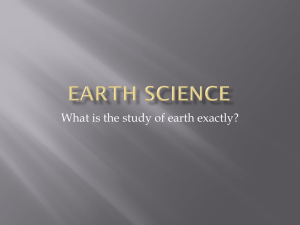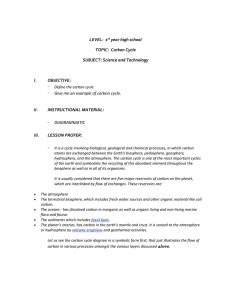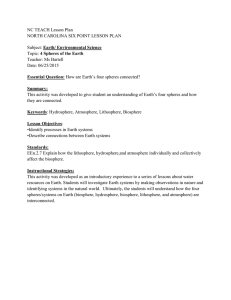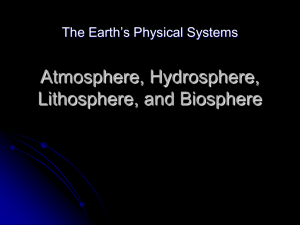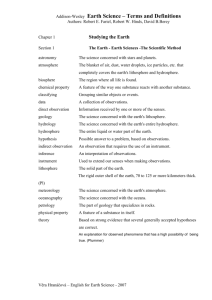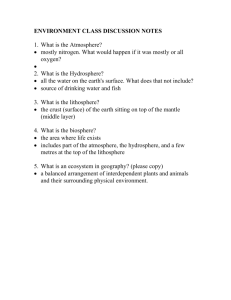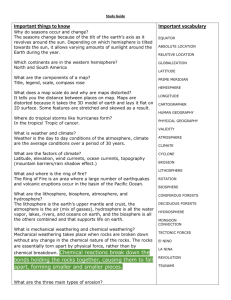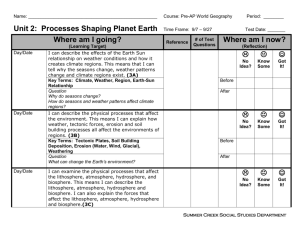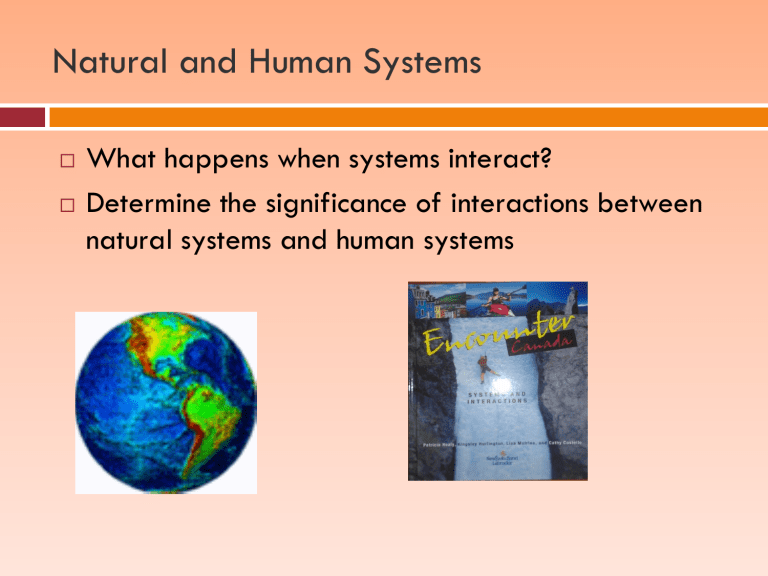
Natural and Human Systems What happens when systems interact? Determine the significance of interactions between natural systems and human systems TERMS System Ecosystem Human System Natural System Systems Approach Dynamic systems Synergy Atmosphere Lithosphere Hydrosphere Biosphere Cryosphere Plate tectonics Energy Photons Photosynthesis Ultraviolet radiation Economics Infrastructure Journey into the World of Systems A complex set of dynamic systems makes up our world. People depend on natural systems for survival Natural systems influence people’s activities Human activities have an impact on natural systems Each region in Canada has a unique combination of natural and human systems. legal solar Journey into the World of Systems What are Systems ? A system is made up of different parts that connect to form a whole. Why is it important to know about systems and how they operate? The interaction of systems on earth shapes the environment in which we live. THEY CAN BE BROKEN INTO 2 CATEGORIES: NATURAL SYSTYEMS HUMAN SYSTEMS Natural System Pg 48 Systems that occur in nature Circulation of water in the ocean Weather and climate Water drainage Energy cycles These systems work together to form the ECOSYSTEMS Ecosystem is a community of plants and animals that interact with one another and with their physical environment (land, climate, soil, water and nutrients). Human System System that are created by humans include: Human settlements Transportation routes Communication systems Economics Infrastructure Energy The Systems Approach Used by geographers to study both natural and human systems Used to helps us make better decisions as we work to create safer and healthier environments. Can help us to protect natural systems and to use resources so they last into the future. Complex Web of Systems A complex set of Dynamic systems make up our world. Dynamic---continually changing. May take millions of years for the change(oil formation) May only take a few minutes for the change (car burning gas) In what ways can a change in one natural system influence that system? Influence another natural system? Greater than the Sum of its Parts Synergy The whole system is greater than the sum of it parts WATER (2 parts hydrogen/1 part oxygen CAR (engine, tires, brakes) Characteristics of Natural Systems The World of Systems Natural Systems: These are systems that occur in nature, and together they form the ecosystems that make up our natural environment. - Circulation of Water in our ocean - Weather and Climate Systems - Energy Cycles - Food Chain Food Chain Earth’s Natural Systems Earth is made up of 4 spheres that are interconnected: Atmosphere Lithosphere Hydrosphere Biosphere Synergy: the whole system is greater than the sum of its part Check out figure 2.3 , 2.4 and 2.5 on pages 50 and 51 of your book. Use the four column chart. Atmosphere Lithosphere Hydrosphere Biosphere Read through pages 51-53 in your book. Record notes in each column as you read through. Don’t forget the sidebar notes! Create a web diagram that illustrates the connection between elements within a natural system. You are the center of this system . Add three relevant elements for each category that impact your everyday life. Be prepared to explain your choices. Air Sun You Water Soil Biosphere Bear Fish Tree Spider MountainL ava Rock Soil Hydrosphere Earth’s Natural Systems Lithosphere Lake, Ocean, Pond, River Clouds Smog Aurora borealis Atmosphere Atmosphere is a layer of gases surrounding the planet Earth that is retained by Earth's gravity. It protects life on Earth by absorbing ultraviolet solar radiation, warming the surface through heat retention (greenhouse effect), and reducing temperature extremes between day and night. Limb view, of the Earth's atmosphere. Colours roughly denote the layers of the atmosphere. Atmosphere Consists mainly of nitrogen and oxygen but also traces of water vapor, carbon dioxide, methane, nitrous oxide, and ozone. Blue light is scattered more than other wavelengths by the gases in the atmosphere, giving the Earth a blue halo when seen from space Lithosphere contains : all of the cold, hard solid land of the planet's crust (surface), the semi-solid land underneath the crust, and the liquid land near the center of the planet. Lithosphere *The surface of the lithosphere is very uneven (see image below). There are high mountain ranges like the Rockies and Andes (shown in red), huge plains or flat areas like those in Texas, Iowa, and Brazil (shown in green), and deep valleys along the ocean floor (shown in blue). CRUSTAL PLATES: pieces of the lithosphere PLATE TECTONICS: slow movement of theses plates on the underlying mantle. This movement causes mountain-building, volcanoes and earthquakes. More on this later! Hydrosphere contains all the solid, liquid, and gaseous water of the planet. Fresh Salty (Ninety-seven percent) Frozen Covers 70% of the Earth’s surface Hydrosphere Some scientists place frozen water--glaciers, icecaps, and icebergs--in its own sphere called the "cryosphere”. The geography of life: Natural Systems Without nature’s system.....no life on Earth (pg 54-56) The atmosphere regulates temperature on Earth This makes water available to living things in liquid form Discuss the Hydrologic Cycle...do activity Water is a chemical substance that is essential to all known forms of life. It appears colorless to the naked eye in small quantities, though it is actually slightly blue in color. It covers 70% of Earth's surface. Water: Most of us take water for granted. Flush toilets, run sinks, water yards. Etc Dripping faucets waste 10 % of water piped into our homes. Many drier areas of the world treat water as if it is gold. Water: We need water to live 2/3 of our body is water Crops and livestock require water Average Canadian uses 300 liters of water per day Add production/manufacturing it is 4000 liters Average daily residential water use per capita (litres per person): United States - 425L Canada - 326L Italy - 250L Sweden - 200L France - 150L Israel - 135L Water Pollution 3 main types of water pollution: Biological Pollution Physical Pollution Chemical Pollution Biological Pollution Bacteria and algae that enter lakes and rivers. Sewage from cities and towns are the largest source. Solved by Reducing sewage from entering water supplies (sewage treatment plants) Physical Pollution Least harmful but most obvious. Floating garbage, paper, tin cans etc. These are easily seen and clean-up and prevention is relative simple. Chemical Pollution Most Dangerous Dumping of poisonous chemicals into rivers and lakes Chemical Pollution Clean-Up there are 2 problems Not able to completely stop chemicals from reaching water supplies Do not have the technology to clean-up chemicals once they are in the water. Biosphere contains all the planet's living things. This sphere includes all of the microorganisms, plants, and animals of Earth. Within the biosphere, living things form ecological communities based on the physical surroundings of an area. These communities are referred to as biomes. Deserts, grasslands, and tropical rainforests are three of the many types of biomes that exist within the biosphere. Food Chain Decay Cycle One animals waste is another Animal’s dinner. Food Web Decomposers Producers Consumers The Decay Cycle There is no waste in natural systems. Creatures such as fungi, insects and bacteria act as decomposers to eat and recycle nature’s waste materials. Energy The fuel of LIFE Most of the Earth's energy comes from the Sun. The rest of it comes from deep inside the Earth Activity pg 142 quide next slide Go to http://eol.jsc.nasa.gov; ACTIVITY You will be given an envelope full of pictures Title your 4 sheets of paper: Atmosphere, Lithosphere, Hydrosphere and Biosphere Glue the pictures on the appropriate sheets Use the sheets to make a “Master Poster” that you will title as “Natural Systems of Earth: The Spheres” Make it neat and tidy and add some personal creativity. Group done Correctly first gets 3 bonus points The best poster gets 7 bonus points (5 for second, 4 for third, and so on) Characteristics of Natural Systems They are driven by energy from the sun Support all living things, including humans Are connected to one another in a complex network of relationships Decompose and recycle all wastes Can be affected by natural events and human influences Are not well understood by humans Operate on very long timelines, from hundreds to millions of years Operate in all four of the earth’s spheres Display synergy Do questions 1-3 on pg 57 Given a natural disaster such as Earthquake, hurricane, flood or drought) Explain the immediate and long term consequences it would have on two nature systems in your area. Human Systems (pg 58) People depend on natural systems for survival Human activities have an impact on natural systems Natural systems influence people’s activities The World of Systems Human Systems: These are systems that are created by people to fill individual and collective needs and wants. Human Systems Create a list of personal needs and wants. Explain how you meet those needs and wants. Classify your needs and wants into the appropriate human system. Human System System that are created by humans include: Human settlements Transportation routes Communication systems Economics Infrastructure Energy Are interconnected in a complicated network of relationships Are not well understood by humans Operate on shorter timelines than natural systems Human Systems Can be affected by outside events and influences Depend on natural systems May recycle wastes but usually end up with some (often a lot) harmful waste Display synergy (when 2 or more parts work together to produce an effect greater than the sum of its parts) Imagine you and your classmates have been stranded on a deserted island. What would be the three most important human systems you would need to establish in order to survive? Why? Once completed, rank the human system in order of importance and justify your reasoning. Humans use technology to harvest natural resources and create lifestyles based on significantly altered environments. We clear forests to build on, create chemicals to control pests, build roads and bridges to connect places, build dams to create hydroelectric power and many other things to shape and transform the Earth’s surface. Transportation & Communication Systems Transportation Systems Interconnecting network of roads, trains, air travel, shipping and cycling routes. Shopping for clothes, music, sports equipment etc. is all part of our ECONOMIC System as well as our transportation system. Transportation Systems are interconnecting networks, such as roads and rail lines, and the bus, cycling, airline etc. routes that move and link people and goods. Gas stations, roads, ferries etc. all support this system. Page 374 of your book has a clear copy of this map Moving people and goods across the nation is an important part of the economy. Canada’s diverse geography means products that are available in one region may not be in another. Our transportation system has played an important role in the development of our country. *Read pages 374-79. The Trans-Canada highway is the world’s largest national highway with 7821 kms of paved highway. Transportation & Communication Systems Communication Systems is a fundamental function of every society. Language, drawing, and writing have always enabled mankind to evolve and to pass on knowledge and values. Interconnecting network of: Phone Television Radio Cell phones Internet web pages News papers Communication Systems Advances in technology have greatly altered how and how quickly we communicate. Read through pages 370373 Take some time to jot down the ‘events’ of your day so far. Five minutes of: - got up when the alarm clock went off - took a shower - ate breakfast Dad cooked - loaded the dishwasher And so on Using the chart like the one below list three clear examples from your (typical) day that fit each column. If stuck, use examples from family, friends or teachers. EXAMPLE “I texted my friend to see if he was taking the car and could pick me up” would fit under communication. transportation communication I texted my friend to see if he was taking the car and could pick me up economic infrastructure energy When filled, go back and make at least one connection for every example. Explain. EXAMPLE: The above example is also economic because the phone had to be purchased and bills must be paid. OR it could connect to energy because the phone had to be charged transportation communication I texted my friend to see if he was taking the car and could pick me up economic the phone has to be paid for and had to be purchased. infrastructure energy the phone had to be charged Infrastructure: how it all works PG.60 Infrastructure: How it all works The basic facilities, services, and installations needed for the functioning of a community or society such as transportation and communications systems, water and power lines, and public institutions including schools, post offices, and prisons Infrastructure: How it all works Water crisis Read the media watch article on p. 62 of your text and then complete question 1, 2, and 3 in your text on p. 63. An Example of Future Transportation Systems Watch the following video and answer the following questions Draw a Venn Diagram comparing possible future transportation systems with those we have today. A Possible Future of Urban Transportation Natural & Human Systems Interact Humans depend on nature for needs (survival) Natural systems influence people’s activities Human activities have an impact on natural systems Humans cannot help but change the natural environment as they us resources (pg 64) Natural & Human Systems Interact Negative and positive consequences of human actions: Changing the landscape (Clear cutting Forest) Health and sustainability of the environment (pollution) Climate change Global warming Read articles pg 65/66 and do question pg 67( #1) Worksheet for question #2 Systems Thinking Geographers investigate the problems that emerge from the way natural and human systems interact Systems thinking can help us to protect natural systems and to use natural resources so that they last into the future ( make them sustainable) Sustainable To conserve natural resources so that they survive for the future generations. Case study pg 70 do worksheet for pg 75

